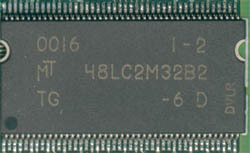Attacking the GeForce2 MX: ATi's Radeon 32 MB SDRAM
Competitors And Differences To High-end Products
When ATi introduced its new flagship Radeon 64 MB DDR in July, they pulled some jokers out of their sleeves that came unexpected. With a new technology, which ATi calls 'HyperZ', the Radeon chip was not quite as exposed to the usual memory bandwidth problems as NVIDIA's GeForce2 GTS. At true color (32-bit color depth) and high resolutions the new ATi chip was even able to overtake the GeForce2 GTS from NVIDIA. However, NVIDIA reacted quickly with its so-called Detonator3 drivers. Those enabled a more effective memory management similar to ATi's HyperZ technology - the only difference is its software management instead of the hard-wired design by ATi. The new drivers helped NVIDIA gain the performance crown again. Meanwhile NVIDIA has upgraded its product line with the GeForce2 Pro and the GeForce2 Ultra. Both graphics chips have a higher performance than the GeForce2 GTS.
Serving the enthusiast is one source of revenue, but NVIDIA entered the mainstream market with a modified version of its GeForce2 GTS. The company lowered the chip clock from 200 MHz to 175 MHz, reduced the number of rendering pipelines from four to two and baptized its new baby 'GeForce2 MX'. In addition to that NVIDIA recommended cheaper SDRAM instead of DDR modules to meet the price expectations. ATi goes a similar way with its Radeon SDR. No architectural modifications were made to the chip but ATi reduced the clock for its 32 MB version from 183 to 166 MHz. As a customer you can now choose between the retail version with DDR SDRAM (DDR = double data rate) or the white-boxed SDRAM version with single data rate.
In the picture below you can see the SDRAM module from Micron found on the Radeon 32 MB SDR . At the lower right corner you can find the '- 6' marking which represents the access time of 6.0 nanoseconds.
The Radeon 32 MB DDR uses memory from Samsung , also with access times of 6.0 nanoseconds. Only the Radeon 64 MB DDR has faster 5.5ns modules from Hyundai .
Get Tom's Hardware's best news and in-depth reviews, straight to your inbox.
Current page: Competitors And Differences To High-end Products
Prev Page Delays Are Bad For The Business Next Page The True Chip Clock - Marketing Versus Reality
